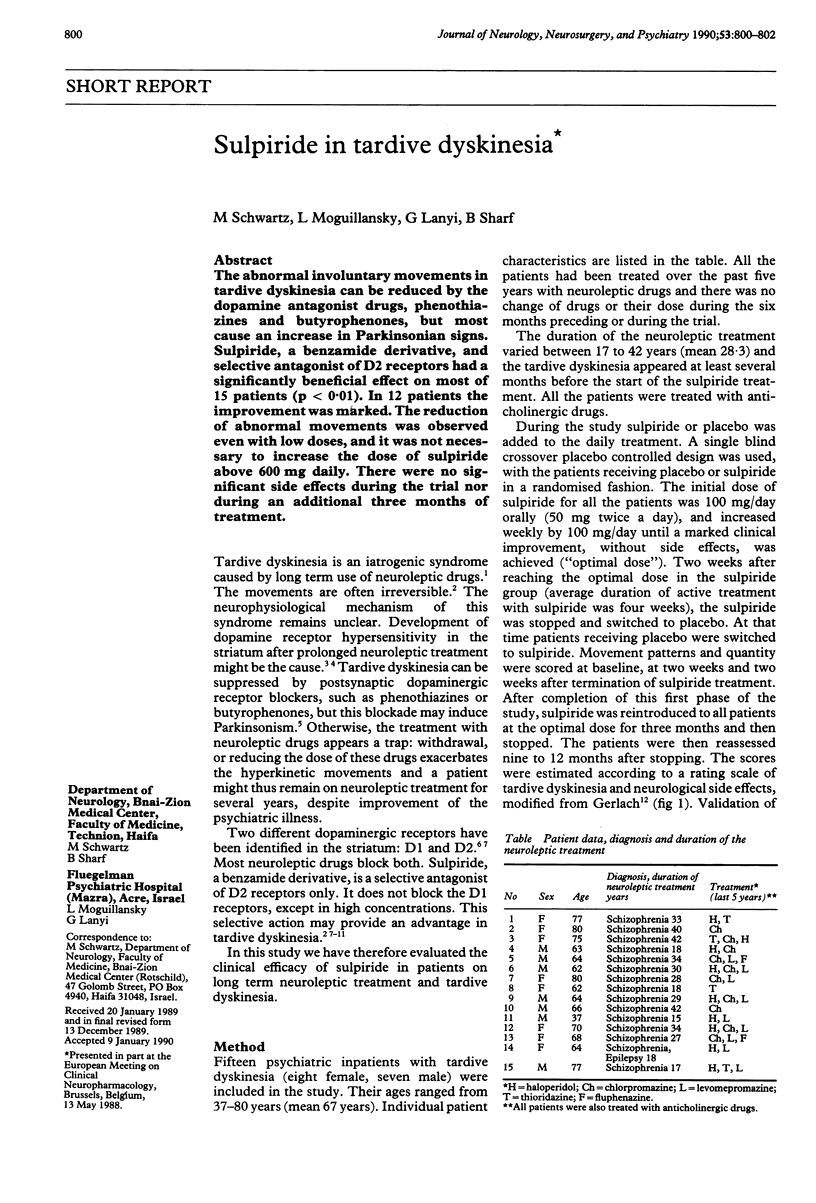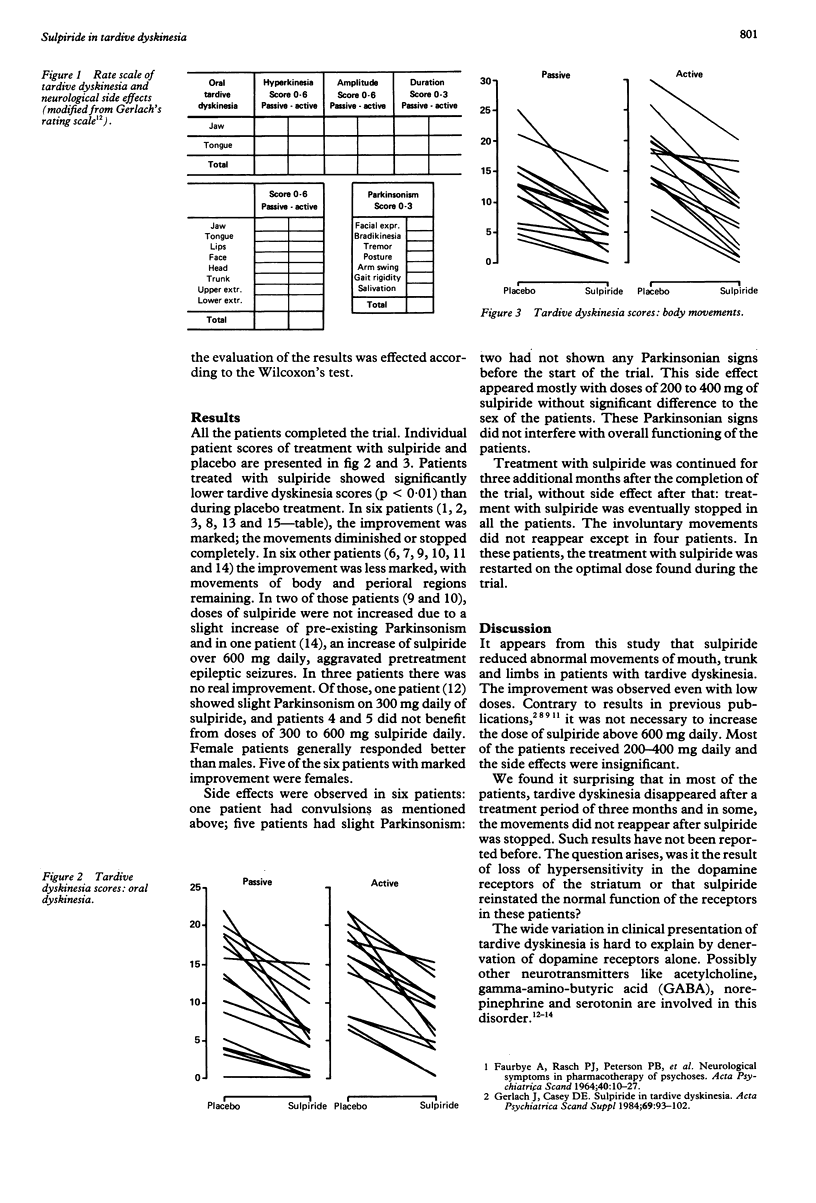Abstract
The abnormal involuntary movements in tardive dyskinesia can be reduced by the dopamine antagonist drugs, phenothiazines and butyrophenones, but most cause an increase in Parkinsonian signs. Sulpiride, a benzamide derivative, and selective antagonist of D2 receptors had a significantly beneficial effect on most of 15 patients (p less than 0.01). In 12 patients the improvement was marked. The reduction of abnormal movements was observed even with low doses, and it was not necessary to increase the dose of sulpiride above 600 mg daily. There were no significant side effects during the trial nor during an additional three months of treatment.
Full text
PDF


Selected References
These references are in PubMed. This may not be the complete list of references from this article.
- Casey D. E., Gerlach J., Magelund G., Christensen T. R. gamma-Acetylenic GABA in tardive dyskinesia. Arch Gen Psychiatry. 1980 Dec;37(12):1376–1379. doi: 10.1001/archpsyc.1980.01780250062007. [DOI] [PubMed] [Google Scholar]
- Casey D. E., Gerlach J., Simmelsgaard H. Sulpiride in tardive dyskinesia. Psychopharmacology (Berl) 1979;66(1):73–77. doi: 10.1007/BF00431993. [DOI] [PubMed] [Google Scholar]
- Clow A., Theodorou A., Jenner P., Marsden C. D. Cerebral dopamine function in rats following withdrawal from one year of continuous neuroleptic administration. Eur J Pharmacol. 1980 May 2;63(2-3):145–157. doi: 10.1016/0014-2999(80)90438-0. [DOI] [PubMed] [Google Scholar]
- FAURBYE A., RASCH P. J., PETERSEN P. B., BRANDBORG G., PAKKENBERG H. NEUROLOGICAL SYMPTOMS IN PHARMACOTHERAPY OF PSYCHOSES. Acta Psychiatr Scand. 1964;40:10–27. doi: 10.1111/j.1600-0447.1964.tb05731.x. [DOI] [PubMed] [Google Scholar]
- Gerlach J., Casey D. E. Sulpiride in tardive dyskinesia. Acta Psychiatr Scand Suppl. 1984;311:93–102. doi: 10.1111/j.1600-0447.1984.tb06861.x. [DOI] [PubMed] [Google Scholar]
- Gerlach J. Tardive dyskinesia. Dan Med Bull. 1979 Aug;26(5):209–245. [PubMed] [Google Scholar]
- Jenner P., Marsden C. D. Substituted benzamide drugs as selective neuroleptic agents. Neuropharmacology. 1981 Dec;20(12B):1285–1293. [PubMed] [Google Scholar]
- Kazamatsuri H., Chien C., Cole J. O. Therapeutic approaches to tardive dyskinesia. A review of the literature. Arch Gen Psychiatry. 1972 Oct;27(4):491–499. doi: 10.1001/archpsyc.1972.01750280059011. [DOI] [PubMed] [Google Scholar]
- Kebabian J. W., Calne D. B. Multiple receptors for dopamine. Nature. 1979 Jan 11;277(5692):93–96. doi: 10.1038/277093a0. [DOI] [PubMed] [Google Scholar]
- Klawans H. L., Jr The pharmacology of tardive dyskinesias. Am J Psychiatry. 1973 Jan;130(1):82–86. doi: 10.1176/ajp.130.1.82. [DOI] [PubMed] [Google Scholar]
- Quinn N., Marsden C. D. A double blind trial of sulpiride in Huntington's disease and tardive dyskinesia. J Neurol Neurosurg Psychiatry. 1984 Aug;47(8):844–847. doi: 10.1136/jnnp.47.8.844. [DOI] [PMC free article] [PubMed] [Google Scholar]
- Schachter M., Bédard P., Debono A. G., Jenner P., Marsden C. D., Price P., Parkes J. D., Keenan J., Smith B., Rosenthaler J. The role of D-1 and D-2 receptors. Nature. 1980 Jul 10;286(5769):157–159. doi: 10.1038/286157a0. [DOI] [PubMed] [Google Scholar]
- Simpson G. M., Pi E. H., Sramek J. J., Jr Management of tardive dyskinesia: current update. Drugs. 1982 May;23(5):381–393. doi: 10.2165/00003495-198223050-00003. [DOI] [PubMed] [Google Scholar]


